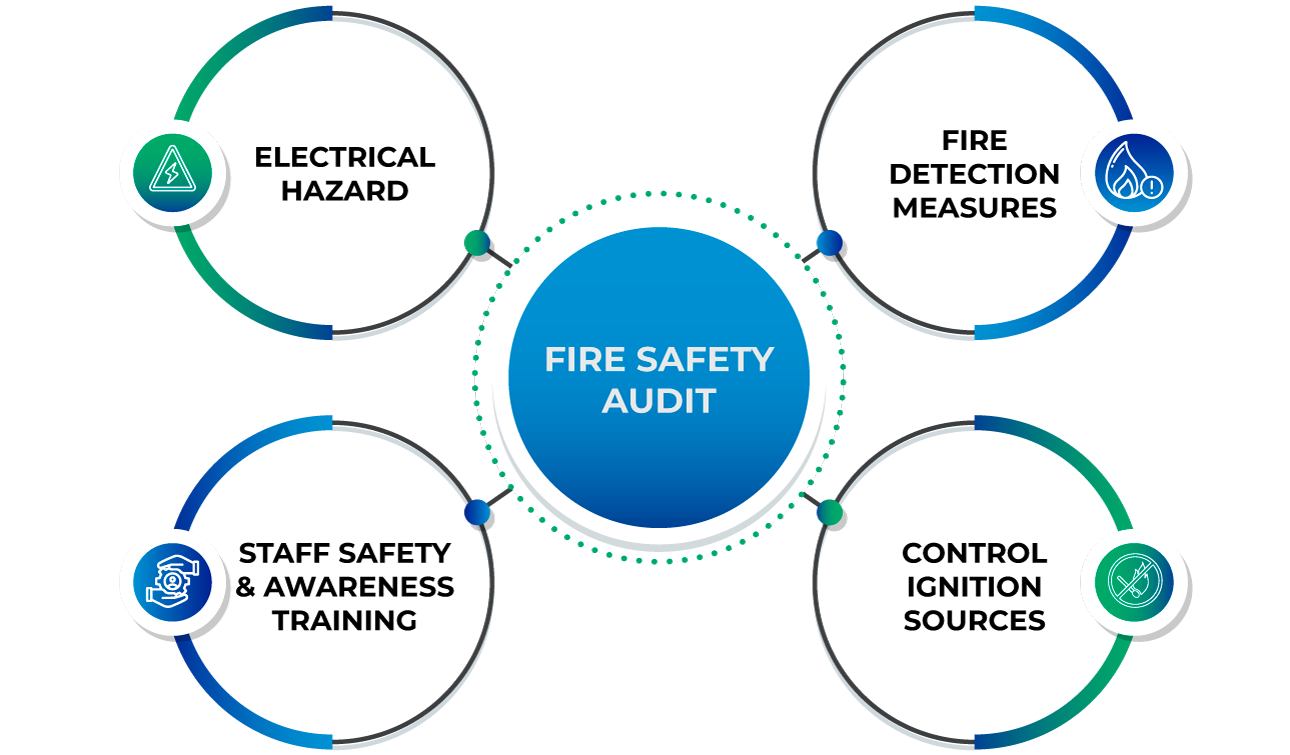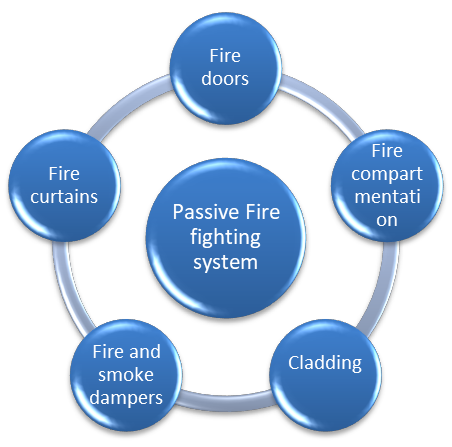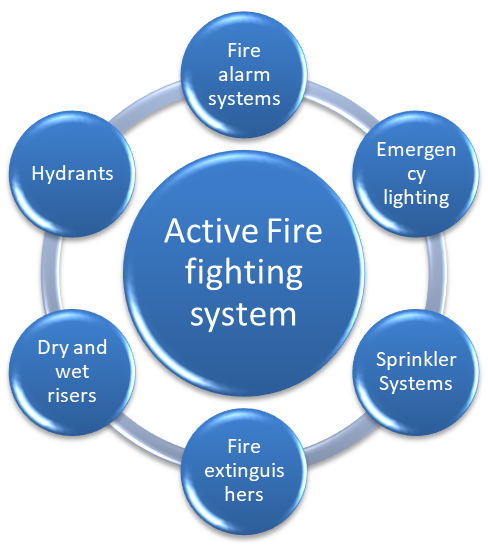Introduction:
A fire safety audit is a method for evaluating a building’s or organization’s fire safety requirements. A thorough fire safety audit looks at the built-in fire risks of routine activities and makes recommendations for how to lower such risks. To effectively address potential fire threats, concentrate on the overall situation of the current fire safety standards in India.
A fire has the potential to do significant damage to both people and property. A fire safety audit is the ideal instrument for assessing the fire safety requirements of the organization. It helps owners identify areas that require improvement and develop action plans, in addition to preparing for crises and conducting drills.

Figure 1: Shows various aspects evaluated in Fire Safety Audit
Indian Fire Services’ Current Situation:
According to the rules of Article 243W of the Constitution, municipalities in India are responsible for carrying out the duties mentioned in the 12th schedule, which includes the provision of fire services. Currently, the concerned states, Union Territories (UTs), and Urban Local Bodies (ULBs) are in charge of organizing services for fire prevention and fire-fighting.
The National Building Code (NBC) is India’s primary model code for concerns pertaining to building construction and fire safety. Fire protection and prevention are state-related issues. The State Governments are largely responsible for fire prevention and fire protection. Municipal by-laws or state regulations serve as the legal framework for fire protection and prevention.
- National Building Code:
The Bureau of Indian Standards is the publisher of the National Building Code. The basic goal of NBC is to describe actions that will offer that level of fire safety that is realistically and practically achievable. According to the Code, all buildings must meet the very minimum fire safety requirements for users and occupants. Use of such equipment/installations duly certified under the BIS Certification Marks Scheme is desired to ensure compliance of fire protection equipment/installations with the established quality requirements.
The NBC divides the structures into the following 9 groups:
These groups have been subdivided into various categories. NBC also deals with three types of fire zones and four types of constructions.


Figure 2 Active and Passive Fire Prevention & Control System
NBC’s Part 4 (Fire and Life Safety), which includes comprehensive regulations on fire prevention, life safety, and fire protection, contains the fire safety standards. Fire protection includes active and passive fire protection systems, as well as plumbing, electrical installations, lighting, ventilation, heating, and air conditioning standards. It also deals with fire prevention and protection. It mentions the limitations on buildings in each fire zone, the categorization of buildings based on occupancy, the delineation of fire zones, height restrictions, building construction types based on the fire resistance of the structural and non-structural components, and other restrictions and requirements necessary to reduce the danger to life from fire, smoke, fumes, or panic before the building can be evacuated.
The Code addresses several issues that are thought to be crucial to the protection of life since it is aware that it involves more than just ways of egress. Therefore, the Code includes provisions relating to means of egress, including exit access, exit, and exit discharge. It also includes requirements for fixed and mobile firefighting systems that are used to protect various types of occupancies from fire (see Table 7 of NBC 2016 which provides for framed External Walls Non-Load Bearing Required to resist fire only from inside the Building).
Part – 4 of NBC 2016 has 11 Annexures
The provisions of Part 4 of the National Building Code are applicable to:
- All high-rise buildings;
- Special buildings are:
- Hotel, educational, institutional, business, mercantile, industrial, storage, hazardous and mixed occupancies, where any of these buildings have a floor area of more than 500 m2 on any one or more floors
- Educational buildings having a height of 9m and above
- Institutional buildings having a height of 9m and above
- All assembly buildings
- Buildings, having an area of more than 300 m’ of incidental assembly occupancy on any floor
- Buildings with two basements or more, or with one basement of the area of more than 500m2.
- State Regulations:
The State fire prevention and fire safety statutes and regulations generally complement the National Building Code. Many of the NBC Code’s provisions have been adopted into the building codes of different State governments and Local Bodies. For instance, the laws and regulations passed by Gujarat and Maharashtra aim to enhance the general level of fire safety measures in those two states.
Many times, the question of who will be in charge of supplying the necessary fire protection and prevention system in a structure or occupancy has been posed. On these matters, the State’s laws and regulations are established. The developer, owner, occupier, or whoever else is referred to, must adhere to all fire and safety regulations set forth by the National Building Code of India, as revised from time to time. If they do not, it will be deemed a violation of the Act. It indicates that the owner or occupier is responsible for maintaining the fire safety installations in a building or an occupancy.
- Fire Safety-Related Regulations:
Apart from the specific State Acts and Rules stated above, several legislations are available on matters relating to fire prevention, and fire protection. Amongst these, the Factories Act and State Factories Rules are important ones. Section 38 of the Factories Act, of 1948, emphasizes the obligations of the occupier, which include:
- To adopt all practicable measures to prevent the outbreak and spread of fire,
- To provide safe means of escape,
- To maintain the firefighting equipment properly and
- To familiarize all the workers with the means of escape during the fire and train them in steps to be taken in a fire accident.
Section 37 of the Factories Act, of 1948 also prescribes detailed measures to prevent explosion hazards. The State Factories Rules, framed under the Factories Act, have prescribed in detail, all the steps to be taken to prevent fire hazards.
- Major Compliances Related to Fire Safety Audits under Part – 4 of NBC 2016:
Numerous industrial installations, high-rise buildings, and commercial and residential structures have been found to violate fire safety regulations. The fire prevention systems that are installed in many occupants’ or groups’ buildings receive little to no regular maintenance.
Although fire safety audits have been proven to be a useful tool for evaluating an organization’s or a building’s fire safety standards, there are no explicit guidelines for a fire safety audit’s scope, objectives, methodology, or frequency in any of India’s fire safety legislation. To ensure fire safety requirements, NBC 2016 advises that essential staff of the building’s tenants conduct frequent fire safety inspections.
Depending on the type of operation and the kind of materials handled in the building, statutory authorities like the State Factory Inspectorate insist on having an external agency conduct a fire safety audit of industrial facilities. The State Fire Prevention and Life Safety Measures Act, which was implemented in various states, including Gujarat and Maharashtra, gave rise to the State Fire Prevention and Life Safety Measures Rules. These rules mandated that building owners and residents undertake a half-yearly fire safety audit and submit the findings to the fire department.
CONCLUSION
It is possible to target Hazard Identification & Risk Assessment (HIRA) to find potential risks. A thorough fire safety audit can address the inherent fire risks connected to regular operations in an occupation and suggest actions to lessen the potential fire risks.
Making Fire Safety Audits mandatory throughout India and giving the audit job to Third Party Agencies with the necessary experience are the best ways to lower the number of fire occurrences in the nation. It is reasonable to do a fire safety audit every tenancy once a year. Above all, all employees inside an occupation must actively cooperate for fire prevention and fire defense to be successful. Always keep in mind that prevention is always preferable to treatment.
Disclaimer
The information provided in this article is intended for general informational purposes only and should not be construed as legal advice. The content of this article is not intended to create and receipt of it does not constitute any relationship. Readers should not act upon this information without seeking professional legal counsel.



